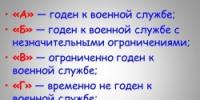OGE social studies demo version presentation of the solution. Online GIA tests in social studies (society). On what scale will the scores be recalculated?
Why then is the OGE (GIA) form more attractive for 9th grade graduates of 2019? Carrying out direct certification in this new form allows you to obtain an independent assessment of schoolchildren’s preparation. All OGE (GIA) tasks are presented in the form of a special form, including questions with a choice of answers to them. A direct analogy is drawn with the Unified State Exam. In this case, you can give both short and detailed answers. Our website website will help you prepare well and realistically assess your chances. Besides, GIA and OGE tests online with answer checking help you decide on your further choice of a specialized high school class. You yourself can easily assess your knowledge in the chosen subject. To do this, our project offers you various tests in a number of disciplines. Our website dedicated to preparation for passing the State Examination Test 2019, grade 9 online, will fully help you prepare for the first serious and responsible test in life.
All materials on our site are presented in a simple, easy-to-understand form. Whether you are an excellent student in your class or an ordinary average student, everything is now in your hands. It would be a good idea for you to visit ours. Here you will find answers to all your questions. Be prepared for the difficult test of the OGE, GIA and the result will exceed all your expectations.
There are documents that regulate the structure and content of CMMs - codifiers and specifications. We invite you to familiarize yourself with them, as well as demo versions of CMMs in all subjects, on our website.
Demo version of the OGE social studies 2018 (GRA 9th grade)
| Demo version of OGE society | option + answers |
| Specification | download |
| Codifier | download |
Total tasks - 31; of these by type of tasks: with a short answer – 25, with a detailed answer – 6; by level of difficulty: B – 16; P – 13; AT 2.
Maximum Primary Score – 39.
Total time for completing the OGE 2018 work in social studies– 180 minutes.
The demo version of the OGE in Society is intended to enable any exam participant and the general public to get an idea of the structure of the examination paper, the number and form of tasks, as well as their level of complexity.
The given criteria for assessing the completion of tasks with a detailed answer, included in the demo version of the examination paper, will allow you to get an idea of the requirements for the completeness and correctness of recording a detailed answer.
The examination paper consists of two parts, including 31 tasks. Part 1 contains 25 short-answer tasks, part 2 contains 6 long-answer tasks.
3 hours (180 minutes) are allotted to complete the examination work in social studies.
Answers to tasks 1–20 are written as one number, which corresponds to the number of the correct answer. Write this figure in the answer field in the text of the work, and then transfer it to answer form No. 1.
The answer to tasks 21–25 is a sequence of numbers. Write your answer in the answer field in the text of the work without spaces, commas or other additional characters, and then transfer it to answer form No. 1.
Part 2 includes the text and 6 tasks for it (tasks 26–31). To complete these tasks you need to: select the necessary information from the text, reveal (including with examples) its individual provisions; correlate information from the text with the knowledge gained while studying the course; apply existing knowledge to analyze social situations; express and justify your own opinion. Answers to tasks in Part 2 are written down on answer sheet No. 2.
When completing assignments, you can use a draft. Entries in the draft are not taken into account when grading work.
Points received for completed tasks are summed up.
Every year, demo versions of the current year’s OGE are published on the official website of FIPI. On August 21, 2017, demo versions, codifiers and specifications of control measuring materials for the 2018 KIM OGE, including social studies, were published.
Demo version of the OGE in social studies 2018 (GRA 9th grade)
| Demo version of OGE social studies | option + answers |
| Specification | download |
| Codifier | download |
Total tasks - 31; of these by type of tasks: with a short answer – 25, with a detailed answer – 6; by level of difficulty: B – 16; P – 13; AT 2.
Maximum Primary Score – 39.
There are no changes in the 2018 KIM in social studies compared to 2017.
System for assessing the performance of individual tasks and the examination work as a whole
Correctly completed work is scored 39 points. Each correctly completed task 1–21, 23–25 is scored 1 point.
Task 22 is scored according to the following principle: 2 points – no errors; 1 point – one mistake was made; 0 points – two or more mistakes were made.
Part 2 tasks are graded depending on the completeness and correctness of the answer.
For complete and correct completion of tasks 26–28, 30 and 31, 2 points are awarded. If the answer is incomplete – 1 point.
For complete and correct completion of task 29, 3 points are awarded. In case of incomplete completion, depending on the representation of the required components of the answer - 2 or 1 point.
Thus, for completing the tasks of Part 2 (correct and complete formulation of answers to all six questions), the examinee can receive a maximum of 13 points.
Basic general education
Social science
Demo version of OGE-2019 in social studies
Demo version, codifier and specification of the OGE 2019 in social studies from the official website of FIPI.Download the demo version of the OGE 2019 along with the codifier and specification from the link below:
Follow the information about our webinars and broadcasts on the YouTube channel; very soon we will discuss preparation for the OGE in social studies.
The structure and books correspond to the modern codifier of content elements in the subject, on the basis of which control measuring materials (CMM) of the OGE are compiled. The manual includes sections: “Man and Society”, “Sphere of Spiritual Culture”, “Economics”, “Social Sphere”, “Sphere of Politics and Social Management”, “Law”. Completeness, compactness, clarity and clarity of presentation - in the form of tables and diagrams - ensures maximum efficiency in preparing for the exam without the use of additional literature.
Students who have successfully passed the OGE in social studies claim that the recommendation to read the entire text of the work before starting assignments has a good effect when completing the work. When reading the work, emotional stress is relieved, brain activity is directed to analyzing the materials, and the graduate is involved in productive cognitive activity, leading to high scores for completing the work. As materials for work, we use the Demonstration version of the OGE in Social Studies 2019, published on the FIPI website.
In total, the option consists of 31 tasks. Part 1 includes 25 tasks, of which the first 20 involve choosing one correct answer from 4 proposed options, and tasks 21-25 require multiple answers. Part 2 contains the text and 6 tasks for it, which require writing a detailed answer to them.
The first 20 tasks of the work test knowledge of the social science course in the following sections: man and society (tasks 1–4), spiritual culture (tasks 5–6), economics (tasks 7-10), social sphere (tasks 11-13), sphere of politics and social management (tasks 14–16), law (tasks 17–20). Tasks 21–31 are not assigned to a specific content line, since they are focused on testing, first of all, subject skills.
Part 1
The answer to tasks 1–20 is one number, which corresponds to the number of the correct answer.
Exercise 1
Which of the following terms is used primarily when describing the political sphere of society?
- tribes, nationalities
- estate, class
- republic, federation
- costs, profit
Specification
control measuring materials for carrying out
in 2018 main state exam
in SOCIAL STUDIES
1. Purpose of CMM for OGE- to assess the level of general education training in social studies of graduates of IX grades of general education organizations for the purpose of state final certification of graduates. The exam results can be used when admitting students to specialized classes in secondary schools.
The OGE is carried out in accordance with the Federal Law of the Russian Federation dated December 29, 2012 N 273-FZ “On Education in the Russian Federation”.
2. Documents defining the content of CMM
3. Approaches to content selection and CMM structure development
The model of the OGE examination paper reflects the integral nature of the subject: in total, the tasks cover the main content lines of the social science course, the basic provisions of various areas of scientific social science.
The objects of control are didactic units of knowledge and requirements for the formation of skills, enshrined in the Federal component of the state educational standard. This is a wide range of subject skills, methods of cognitive activity and knowledge about society in the unity of its spheres and basic institutions, about the social qualities of the individual and the conditions for their formation, about the most important economic phenomena and processes, about politics, law, social relations, and the spiritual life of society.
KIM tasks for the OGE vary in form and level of complexity, which is determined by the method of cognitive activity necessary to complete the task. Completing CMM tasks involves the implementation of such intellectual actions as recognition, reproduction and extraction of information, classification, systematization, comparison, specification, application of knowledge (based on a model or in a new context), explanation, argumentation, evaluation, etc. Tasks of increased and high levels of complexity , in contrast to basic ones, involve more complex, usually complex in nature, cognitive activity.
The specifics of the subject and social and humanitarian knowledge in general are also taken into account when selecting sources of information used in the examination work. These are, as a rule, the results of sociological research, adapted texts from popular scientific, socio-philosophical publications, and extracts from legal acts. For tasks on distinguishing between judgments reflecting facts and evaluative statements, small texts are constructed that are similar in style to media information messages.
4. Connection of the OGE exam model with the Unified State Exam KIM
A number of tasks in the exam model of the OGE are similar in type to the tasks of the Unified State Exam. This approach seems completely justified, since the list of skills being developed and the basic components of content in primary and high school largely coincide. In addition, this approach allows, taking into account the role of the state final certification of primary school graduates in the emerging all-Russian system for assessing the quality of education, to ensure continuity of the two stages of the state final certification.
At the same time, when developing KIM for the OGE, the cognitive capabilities of primary school students, the volume and nature of the educational content presented to them in the subject were taken into account. This predetermined the features of the OGE examination model. The most significant differences from the KIM Unified State Examination have part 2 of the examination paper, which is not only an independent, but also an internally integral section: all six tasks of different types here are directly related to a specially selected text that illuminates a certain aspect of social reality.
5. Characteristics of the CMM structure
The examination paper consists of two parts, including 31 tasks. Part 1 contains 25 short-answer tasks, part 2 contains 6 long-answer tasks.
For each task 1-20 of the work, four answer options are offered, of which only one is correct. The task is considered completed correctly if the student writes down the number of the correct answer. The task is considered not completed in the following cases: a) the number of the incorrect answer is recorded; b) the numbers of two or more answers are recorded, even if the number of the correct answer is also indicated among them; c) the answer number is not recorded.
In tasks 21-25, the answer is given as a sequence of numbers (for example, 125), written without spaces or separating characters.
Answers to the tasks of Part 2 are independently formulated and written down by the examinee in detailed form. Their implementation is verified by experts based on a specially developed system of criteria.




